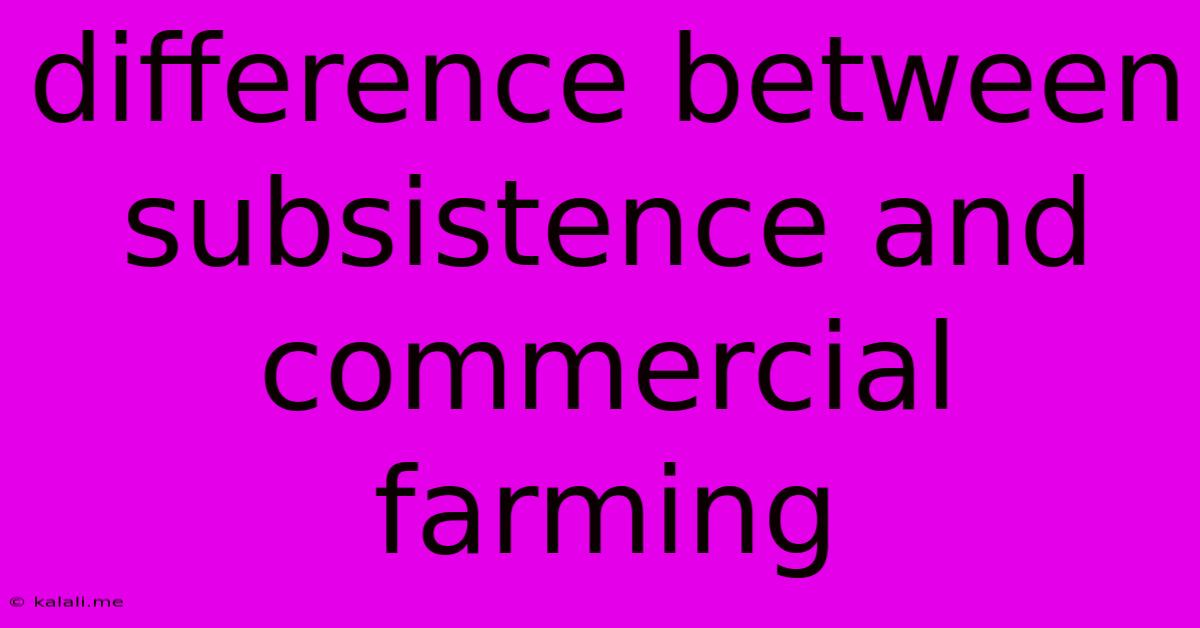Difference Between Subsistence And Commercial Farming
Kalali
Jun 12, 2025 · 3 min read

Table of Contents
Subsistence vs. Commercial Farming: A Deep Dive into Agricultural Practices
Understanding the differences between subsistence and commercial farming is crucial for grasping the complexities of global food production and its impact on economies and societies. While both involve cultivating crops and raising livestock, their motivations, scales, and methods differ significantly. This article will delve into these key distinctions, helping you understand the nuances of each farming approach. This comparison will explore factors such as scale of operation, technology employed, market orientation, and overall economic impact.
What is Subsistence Farming?
Subsistence farming is a traditional agricultural practice where farmers primarily grow enough food to feed themselves and their families, with little to no surplus for sale. It's characterized by small-scale operations and reliance on manual labor, often employing simple tools and traditional techniques passed down through generations. The focus is on self-sufficiency and meeting immediate household needs. Think of small plots of land cultivating staple crops like maize, rice, or potatoes, alongside maybe a few chickens or goats.
Key Characteristics of Subsistence Farming:
- Small scale: Typically involves small landholdings, often less than a few hectares.
- Limited technology: Relies heavily on manual labor and simple tools; minimal use of machinery or advanced technology.
- Low productivity: Yields are generally low due to limited resources and technology.
- Self-sufficiency: The primary goal is to produce enough food for the farmer's family.
- Traditional methods: Techniques are often passed down through generations, with limited adoption of modern farming practices.
- Environmental sustainability (often): Often utilizes sustainable farming practices due to reliance on natural resources and limited use of chemical inputs.
What is Commercial Farming?
Commercial farming, in contrast, is geared towards producing agricultural products for sale in the market. This is a large-scale operation focused on maximizing profits through efficiency and economies of scale. It typically involves significant investment in technology, machinery, and infrastructure. Commercial farms often specialize in a particular crop or livestock, aiming for high yields and market competitiveness.
Key Characteristics of Commercial Farming:
- Large scale: Involves extensive landholdings and high production volumes.
- High technology: Employs advanced machinery, irrigation systems, fertilizers, and pesticides to maximize yields.
- High productivity: Achieves high yields per unit of land through efficient technology and practices.
- Market orientation: Primarily focused on producing goods for sale in local or international markets.
- Specialization: Often concentrates on a specific crop or livestock, enabling efficient production and marketing.
- Capital intensive: Requires significant investment in land, machinery, and other resources.
- Potential for environmental impact: The use of intensive farming methods can sometimes lead to negative environmental consequences.
Comparing Subsistence and Commercial Farming: A Table Summary
| Feature | Subsistence Farming | Commercial Farming |
|---|---|---|
| Scale | Small | Large |
| Goal | Self-sufficiency, family needs | Profit maximization |
| Technology | Low, manual labor | High, mechanized |
| Productivity | Low | High |
| Market | Primarily local or no market | Primarily global or national markets |
| Specialization | Diverse crops and livestock | Specialized crops or livestock |
| Capital | Low | High |
| Labor | Family labor, often high labor input | Lower labor input per unit of production |
Conclusion:
While both subsistence and commercial farming are vital to global food security, they differ dramatically in their scale, methods, goals, and impact. Subsistence farming provides food security for families and communities, often emphasizing traditional practices and environmental sustainability. Commercial farming, on the other hand, plays a crucial role in feeding global populations and driving economic growth, but it may raise concerns regarding environmental sustainability and equitable distribution of resources. Understanding these differences is crucial for developing sustainable and equitable agricultural policies and practices.
Latest Posts
Latest Posts
-
A Step Up Transformer The Voltage And The Current
Jun 13, 2025
-
Which Of The Following Would Be
Jun 13, 2025
-
What Is The Largest Storage Device On A Computer
Jun 13, 2025
-
Transfer Function Of Low Pass Rc Filter
Jun 13, 2025
-
How Many Valence Electrons Are In Rubidium
Jun 13, 2025
Related Post
Thank you for visiting our website which covers about Difference Between Subsistence And Commercial Farming . We hope the information provided has been useful to you. Feel free to contact us if you have any questions or need further assistance. See you next time and don't miss to bookmark.